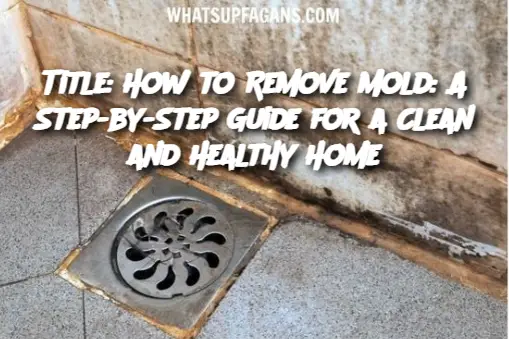-
Identify the Affected Areas: Inspect your home for visible mold growth, particularly in areas with high humidity such as bathrooms, kitchens, basements, and around windows. Mold typically appears as black, green, or white spots, but can also be a powdery or fuzzy texture depending on the type.
-
Protect Yourself: Before you begin cleaning, protect yourself from mold spores by wearing gloves and an N95 mask. This is especially important if you’re dealing with a large infestation. Open windows or doors for ventilation during the process.
-
Choose Your Cleaning Solution:
- Vinegar Solution: Fill a spray bottle with white vinegar and spray it directly onto the moldy surface. Vinegar is effective at killing most types of mold and has antifungal properties.
- Hydrogen Peroxide Solution: If you prefer, use hydrogen peroxide (3% solution) in a spray bottle. Hydrogen peroxide is a strong antifungal agent that works well against mold and mildew.
- Baking Soda Solution (optional): For tougher mold spots, mix a tablespoon of baking soda with a cup of water and stir to create a paste. You can apply this paste on the affected areas after spraying with vinegar or hydrogen peroxide for extra scrubbing power.
-
Apply the Solution: Spray the solution generously onto the mold-affected areas. Let it sit for at least 10-15 minutes to allow the solution to penetrate and kill the mold spores.
-
Scrub the Area: After the solution has had time to sit, use a scrub brush or sponge to scrub the moldy areas. Work gently to avoid damaging the underlying surface. For stubborn mold, apply more solution and continue scrubbing until the mold is removed.
-
Wipe and Dry the Surface: Once the mold is gone, use a microfiber cloth or towel to wipe away the cleaning solution and any remaining mold. Make sure to dry the area completely. Mold thrives in damp conditions, so it’s important to prevent moisture buildup by using a fan or dehumidifier to thoroughly dry the surface.
Serving and Storage Tips:
-
Prevention Tips: To prevent mold from returning, consider using a dehumidifier or an exhaust fan in damp areas, especially in the bathroom and kitchen. Repair any leaks in pipes or roofs to prevent water from seeping in. Regularly clean areas prone to moisture with a mixture of water and vinegar to keep mold from regrowing.
-
Storage: Keep any leftover cleaning solution in a sealed container for future use. If using vinegar or hydrogen peroxide, ensure the container is kept in a cool, dry place out of direct sunlight to maintain its potency.
Variants:
-
Tea Tree Oil Solution: If you prefer an all-natural solution, mix 1 teaspoon of tea tree oil with a cup of water. Spray this mixture on the moldy surface. Tea tree oil has antifungal and antibacterial properties and is an effective mold killer.
-
Lemon Juice and Baking Soda Paste: For a fresh, pleasant-smelling alternative, combine lemon juice with baking soda to form a paste. This can be applied to stubborn mold spots for an added boost of antifungal properties.
-
Borax Solution: Borax is another natural mold killer. Mix a cup of borax with a gallon of water and scrub the mold with a brush. Borax also helps prevent mold from returning.
FAQ:
Q: How can I tell if mold is affecting my health? A: Mold exposure can lead to symptoms like coughing, sneezing, watery eyes, skin irritation, and respiratory issues. If you experience these symptoms, it’s important to address mold growth in your home immediately.
Q: Can I remove mold from drywall or ceiling tiles? A: Yes, mold can be removed from drywall or ceiling tiles using the methods mentioned above. However, if the mold has penetrated deeply into these materials, you may need to replace the affected sections of drywall or tiles, as it can be difficult to remove the mold completely from porous surfaces.
Q: Is it safe to use bleach for mold removal? A: While bleach is sometimes recommended for mold removal, it’s not always the most effective choice, especially for porous materials like wood or drywall. Bleach can kill surface mold but may not penetrate deep enough to kill the spores in porous materials. Vinegar, hydrogen peroxide, and baking soda are often safer and more effective alternatives.
Q: How do I prevent mold from coming back? A: To prevent mold from returning, control moisture levels in your home. Use dehumidifiers, improve ventilation, and fix any leaks promptly. Regularly clean areas prone to moisture with natural antifungal solutions like vinegar or essential oils to keep mold at bay.
